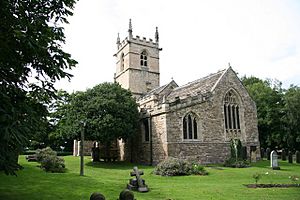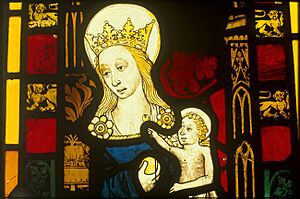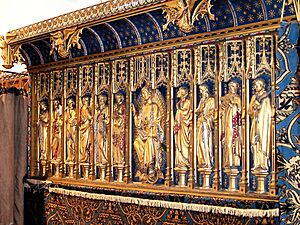St James' Church, High Melton facts for kids
Quick facts for kids St James' Church, High Melton |
|
|---|---|

St James' Church, High Melton
|
|
| 53°30′38″N 1°14′02″W / 53.5105°N 1.2338°W | |
| OS grid reference | SE 50917 01811 |
| Denomination | Church of England |
| Churchmanship | Broad Church |
| Website | www.barnburghandharlington.co.uk |
| History | |
| Dedication | St. James |
| Administration | |
| Parish | High Melton |
| Archdeaconry | Doncaster |
| Diocese | Sheffield |
| Province | York |
St James' Church, High Melton is an old church in High Melton, a village in South Yorkshire, England. It's part of the Church of England.
Contents
History of St James' Church
St James' Church is a very old building in High Melton, near Doncaster. It started way back in Saxon times. Most of the church you see today was built around 1100 AD. In 1153 AD, it was given to a group of Cistercian nuns at Hampole Priory to look after. It was like a smaller church (a 'Chapel of Ease') connected to their main priory.
For a long time, until at least the late 1300s, the church was called the "Church of All Hallows." Nuns from Hampole Priory and their helpers (called Chaplains) looked after it. Around this time, a tower was added to the church. Also, a special small chapel called a Lady Chapel was built on the south-east side.
Because of these additions, the church has an unusual layout. It has two main paths (called aisles). One goes through a short main area (the nave) and into the chancel (the area near the altar) and the tower. The other path runs along the whole south side of the church, leading to the Lady Chapel.
Before the English Reformation (a big change in the church in the 1500s), High Melton didn't have its own church area (called a parish). It was still guided by the Hampole Priory. The priory appointed a helper (a Curate) and collected money from the church lands. The first official church leader (a Vicar) for Melton-on-the-Hill was appointed in 1660. This happened after the English Civil War and the return of the king.
People Who Helped the Church
Over the years, many generous people have helped St James' Church. These include the Fountayne family and their relatives, the Wilson family. The Wilsons later changed their name to Montagu. There are large memorials inside the church that remember these families. Several Fountayne family members are buried under the chancel. The Montagu family's marble graves are in the northern part of the churchyard.
Another local family connected to the church was the Levetts of High Melton. They moved there from nearby Normanton. John Levett of High Melton married Mary, whose family owned the High Melton manor. The coat of arms (family symbol) of the Levetts, along with other important local families, can be seen in a stained glass window in St James' Church.
Generous people also helped improve the church in the early 1900s. For example, there is a beautiful rood screen from 1905. This screen has figures showing the crucifixion. There is also a special screen behind the altar (a reredos) and altar cloths (altar frontals) from 1907. These were all made by a famous artist named Sir John Ninian Comper. He also did a lot of work for York Minster. The rood screen hides a remarkable arch (the chancel arch). This arch is thought to be one of the oldest examples of Norman architecture in the area.
Beautiful Stained Glass Windows

St James' Church is also famous for its lovely windows. One of these windows was also made by the Comper Studio. John Fountayne, who was the Dean of York, put several pieces of mediaeval stained glass in the church. He got these from different places around the county.
One notable window shows William de Melton, who was the 43rd Archbishop of York from 1317 to 1340. There are also small pieces of a 'doom scene' from the Jesse Tree window of York Minster.
John Fountayne was the main landowner (the Lord of the Manor) of High Melton from 1739 to 1802. He also added painted glass by William Peckitt and stained glass from a very important 14th-century artist, Thomas Glazier. This gave the church a rich collection of beautiful glass. Some of the stained glass, including panels with family symbols, were moved from the Great Chamber of the Old Hall. This happened when Dr. Fountayne updated the Hall in the mid-1700s. The two East Windows are examples of work by Charles Eamer Kempe.
Church Records
The church's official records, called Parish Registers, started in 1538. This is quite early, as many other churches only began keeping records around 1558.
The Church Organ
The church has a pipe organ that was made in 1898 by Forster and Andrews. It has two keyboards (called manuals) and uses a system called tracker action. You can find more details about this organ on the National Pipe Organ Register website.
Tower, Bells, and Clock
The church tower is built in three parts. It is mostly in the Perpendicular style. The bottom part was built in the 1300s, with more parts added in the 1400s and 1600s. The second part of the tower is where the bells are rung. It has a large stone fireplace on one side. People in the area say that church helpers (curates) used to live there before the king returned to power.
The tower holds three bells, but they cannot be rung right now. The largest bell weighs about 350 kilograms (7cwt). It makes a B flat sound. This bell was made in 1636 in Doncaster. It has the words "Soli Deo gloria" written on it, which means "Glory to God alone." This was an important saying during the Protestant Reformation.
The second bell makes a C sound and is the oldest. It was made between 1500 and 1510, before the Reformation. It is dedicated to Saint Anthony. The smallest bell makes a D sound. It was made around 1590.
The clock on the tower has an unusual stone face. It was built in 1788 and has not been working for many years.
How the Church is Used Today
St James' Church is part of the Diocese of Sheffield. It is now linked with St Peter's Church in Barnburgh and St John the Baptist Church in Adwick-upon-Dearne.
See also
- Grade II* listed buildings in South Yorkshire
- Listed buildings in High Melton


